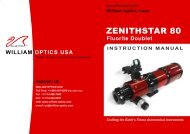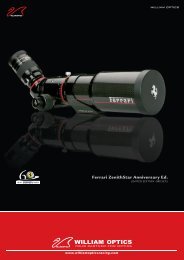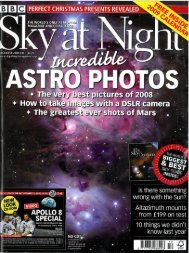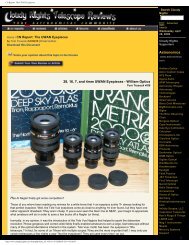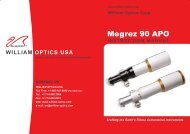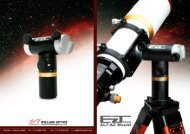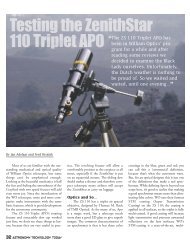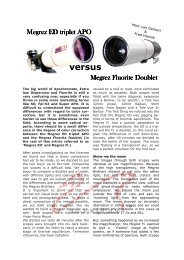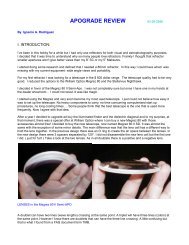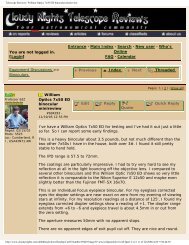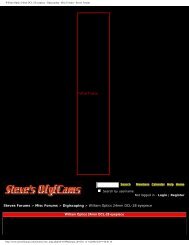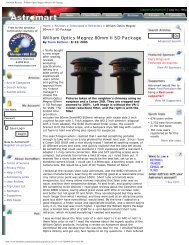CN Report: William Optics Zenithstar 80 - Cloudy Nights
CN Report: William Optics Zenithstar 80 - Cloudy Nights
CN Report: William Optics Zenithstar 80 - Cloudy Nights
Create successful ePaper yourself
Turn your PDF publications into a flip-book with our unique Google optimized e-Paper software.
Copyright © 2005 <strong>Cloudy</strong><strong>Nights</strong> Telescope ReviewsOptical quality is very important in an astronomical instrument, but make no mistake - Ifyou are talking only in terms of what you can see with a given telescope – aperture wins.And significant aperture wins significantly. Nearly any of the inexpensive 8” reflectorson the market should outperform any <strong>80</strong> mm scope. An 8” reflector will go deeper (letyou see fainter objects) and show you more detail – if the proper strictures are observed.So if bigger is better, why do refractors command such a following?Let’s consider the advantages of an <strong>80</strong>mm refractor:• Portability – an <strong>80</strong>mm scope is FAR more portable than most of the 8” refractorson the market. They say the best scope is the one you use most often, and whileI’d never be without at least an 8” dob, I have to admit it would be very tough topart with a small refractor as well.• Quick cool down times – doublets especially are great for those quick peeks.Many’s the night I’ve gotten home from work late and didn’t want to take thetime for the newt to cool down. Refractors (especially the doublets with welldesigned lens cells) are usually ready for deep sky immediately, and lunar andplanetary in short order.• Reduced need for collimation – no need to tweak collimation before the beginningof every session – most refractors will never need to be collimated by the enduser, and should even put up with a moderate amount of abuse without manyissues.While a small quality apo may stretch the budget, small achros are far more reasonablypriced, and make a great compliment to a larger reflector. Their small size and lightweight helps ensure that you take them with you when traveling. Little refractors providesharp, wide fields of view for those immense clusters and do well for ole luna and theplanets too. If you haven’t scanned the summer milky way with a wide field scope, youdon’t know what you are missing out on.Personally, I happen to think that every amateur needs (at least) two telescopes – a largelight bucket, and a small refractor. Think of them as different kinds of fishing tackle.You’ll catch different things with each, but both are great ways to pass the time.In this article, I take a look at one of the more popular <strong>80</strong>mm achros on the market today– the <strong>William</strong> <strong>Optics</strong> ZenithStar <strong>80</strong>.2
Copyright © 2005 <strong>Cloudy</strong><strong>Nights</strong> Telescope Reviews<strong>William</strong> <strong>Optics</strong> ZenithStar <strong>80</strong>Price $399Focal Length: 4<strong>80</strong>mmAperture: Sample 1 - <strong>80</strong> (advertised), 72-74mm Effective (approximation), Sample 2– 78-<strong>80</strong>mm EffectiveWeight: 5.3 lbsFocal Ratio: f6 (Sample 2), f6.5 (Sample 1)Highest Typical Effective Power: 120x-160xFocuser: 2” Crayford w/ rotate able backZenithStar <strong>80</strong>HOTSNOTS• Lightweight• Top NotchMechanics• CrayfordFocuser• Anodized OTA• CompressionRing Fittings• 2” Focuser• Some OpticalVingetting onearly models• Lens can’t becollimated byend user• No elegant wayto mount anRDFThis is a jet black glossy anodized optical tube assembly that’s offset beautifully by it’sgolden trim and slide on lens cap. This little piece of art comes complete with it’s ownbriefcase style carrying case, 1.25” to 2” compression ring adapter, and L mountingbracket (with 2 ¼-20 holes) for mounting on standard camera tripods. The L bracket nowcomes with cork on the bottom, and is removable if you want to use the scope with a setof rings instead (not supplied).The crayford focuser is very smooth, noticeably smoother most typical rack and piniontype focusers. It is adjustable and lockable. In addition, the entire focuser back rotates –a boon for the astrophotographer, but less so for the visual observer as one can alwaysrotate the star diagonal. The dew shield retracts,reducing the overall length of the tube for storage andtravel. Compression ring fittings are foundthroughout.The ZenithStar <strong>80</strong> is a gorgeous little telescope, thatgives a very high impression of quality. The glossyanodizing (and yes, it IS anodizing) means no paint –and no paint means no paint chips. While it’s aprettier finish than traditional paint or enamel, I’m notcompletely convinced it’s tougher. It’s probablyclose enough that makes no difference however. Theone obvious down side is that it is so smooth, it showsfingerprints very easily. You’ll want to keep a smallpolishing cloth on hand. Suffice it to say, I found themechanics and fit and finish top notch as good asthose found in telescopes many times the ZS<strong>80</strong>’smeager price.The overall light weight of the telescope and included L-bracket means it couples fairlywell with just about any lightweight mount and tripod – even mounting on a mediumweight photo / video tripod in a pinch – a bonus for travelers who wish to go as light aspossible.3
Copyright © 2005 <strong>Cloudy</strong><strong>Nights</strong> Telescope ReviewsThe optics consist of an achromatic cemented doubletand there is no provision for adjustment or collimationof the lens in the cell.This means that if the scope is miscollimated, there’s agood chance it will have to go back to the dealer orfactory. Fortunately, it’s been my experience thatrefractors are fairly durable, and very slightmiscollimation isn’t often that big of a deal.That being said, the first ZS<strong>80</strong> I was sent was ratherseverely out of collimation. (DOH!) I contactedExcellent coatings Astronomics and exchanged it for another unit. Startests on the second showed it to be much better – stillnot quite perfect, but overall it was good enough that I judged that it to have a negligibleeffect on performance.You may have noted that I approximated the effective aperture of the first samples assomewhere around 72-74mm. (Before I go any further, I’d like to note that this has beenfixed in current telescopes – but we’ll get to that later.) The reduced aperture was due tothe rather unique baffle system WO chose to employ. Traditional baffles – or knifeedged baffles – are typically simplythin strips of metal inside the OTAthat do not impinge into the lightpath, but are strategically placed toblock incidental light in order toincrease contrast. Another commonmethod of baffling is to use a specialtype of flocking paper (resemblingblackened sand paper) instead of theknife edged baffles. Although somepundits prefer the traditional method,it’s been my experience that thissandpaper approach also works well.With this scope, WO is using adifferent system entirely. The baffleis an internally ridged cone thatattaches to the lens cell itself –serving the dual purpose of the lenscell retaining ring and baffle. It’sthis light baffle cone that impingedon the light cone and thus reducedthe effective aperture.The ZenithStar <strong>80</strong>’s baffle system also serves as a lensretaining ring, and was the cause of the vingetting. On theleft, the “fixed” baffle (note the extension tube), on the right,the older one that created the vingetting problem – both areshown attached to the lens cell.4
Copyright © 2005 <strong>Cloudy</strong><strong>Nights</strong> Telescope ReviewsI found them to be very good when it came to technical support and communications, forthe most part both returned e-mails quite promptly, and as a customer there would havelittle doubt that they would do their best to ensure my satisfaction. I had a very positiveexperience overall.Bottom line?For the advanced amateur, the one drawbackmay be its lens design – the fact that it’s acemented achromatic doublet means that if it’sout of collimation – it’s out. Contact WO oryour dealer for replacement. And yet, I thinkthere are certain advantages to this approach aswell. As a cemented doublet, it’s impossible forthe lenses to go out of collimation with respectto each other – no matter how much bangingaround it takes. This is one less source ofpotential problems, and I think that given its target market, it was an excellent choice.For the beginner or traveler, this is a nearly perfect small achromat. The optics are morethan acceptable given its modest cost. And as for the rest; lightweight and portable, thefit and finish are fantastic – equal to scopes costing several times its price. This makes anexcellent introductory refractor for someone wanting to dip their toe into that pool, andcomes close to being the ultimate travel telescope for the more advanced amateur lookingfor an option that won’t break the bank.Available from :Astronomics (among others)http://www.astronomics.comDiscuss this Article in the <strong>Cloudy</strong><strong>Nights</strong> ForumsAll pictures are copyright <strong>Cloudy</strong><strong>Nights</strong>.com6



